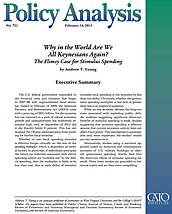Whether or not fiscal spending stimulus is effective hinges critically on the size of the spending multiplier, which is dependent on several factors. In particular, if individuals anticipate the future tax liabilities associated with deficit spending and/or are “crowded out” by the deficit spending, then the multiplier is likely to be less than one; that is, each dollar of stimulus increases total spending in the economy by less than one dollar. Ultimately, whether the government spending multiplier is less than or greater than one is an empirical question.
While no one seriously debates the long-run costs associated with exploding public debt, the evidence suggesting significant short-run benefits of stimulus spending is weak. Studies suggesting that stimulus spending is effective assume that current economic activity does not affect fiscal policy. This assumption is questionable and, most important, the studies’ results are very sensitive to it.
Alternatively, studies using a narrative approach based on historical and contemporary accounts of U.S. military buildups to identify government spending shocks find that the short-run effects of stimulus spending are small. These latter studies are grounded in historical reality and are thus more compelling.

